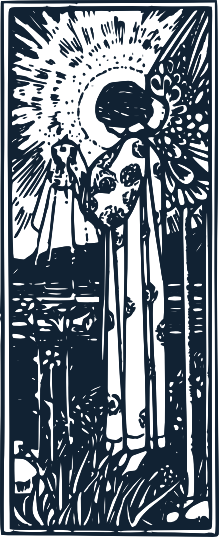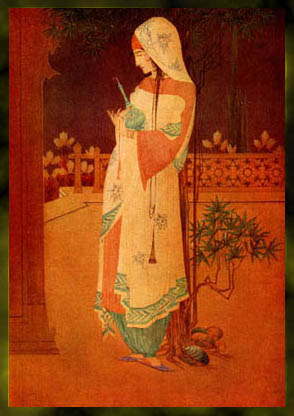

|

Florence Harrison: Grail Maiden, 1912.
This png image based on original gif image
provided by University of Rochester. |
The above excerpt from Rumi's Mathnawi is referenced (by R.A. Nicholson in his own translation) to sayings attributed to one of the great saints of early Islam, Bayazid Bastami (804-874 CE). At the first great encounter between Rumi and Shams, the man who would become his close companion, Shams challenged Rumi to compare the prophet Muhammad with the saint Bayazid. Rumi replied, appropriately or in conformity with classic Islamic belief, that Muhammad had progressed through seventy levels every day while Bayazid had stopped at the first level, believing he had already achieved perfection.
Be that as it may, it is clear that Rumi did nevertheless revere Bastami and his idea that the water of life, its pourer, and its drinker form a unity is a clear echo of Bastami's similar idea, in which it is wine that is poured and drunk. Both ideas posit a unity in a divine trinity or a Triune God, an archetypal theme found in many of the world's mythologies but central, of course, to Christianity. Shown below is a famous Christian icon depicting the trinity.
icon by Russian artist, Andrei Rublev c. 1360-1430 |
In this image, the three angels that visited Abraham (Genesis 18) are depicted. Though three in number, they are also referred to as a visitation from "the Lord", implicitly The One. The unity of the threesome is conveyed by the artist through the bowl or cup at the centre as well as through the containing circular form of the composition. What contains the three (the envelope) is also the centre (the nub) that holds them all together. This Old Testament trinity is seen, of course, by Christians as a foretaste of the later trinity, clarified now as God the Father, God the Son, and God the Holy Ghost (or Spirit). In some images of this trinity the cup appears as a receptacle for Christ's blood and in the "vierge ouvrante" statues, it is the Great Mother as Virgin Mary that contains the Divine Trinity. |
There is, therefore, always this fourth and unifying entity that is both the source and the end point of unity. As the early alchemist, Maria Prophetissa, is said to have put it:
One becomes Two,
Two becomes Three,
and out of the Third comes the One as the Fourth.
There are, in fact, two original Ones in this schema: the Great Mother as original whole and the Great Father as creator and generative principle. The second element is the Son and the third the Spirit. Finally, the whole returns to unity in the original One though now with the difference that distinctions have been made and transcended.

Persian miniature of a female saqi or cupbearer. |
The parallels with Bayazid are as follows:
|
The further parallels inside orthodox Islam are as follows:
- Allah, like the saqi, covers both the original Great Mother and Great Father.
- Mohammad is the cup that received God's Word.
- The Koran is the wine or the Word itself.
- Muslims themselves are the community receiving the wine.
- Allah, Mohammad, the Koran, and the community of Muslims form one unity in The One.
These mythopoetic elements in the Judaic, Christian, and Islamic trinities are not hard-and-fast. Like all such elements, they are fluid and any one element can readily flow into any other. Thus can Mohammad be seen in the role of Great Father (as non-Muslims see him, that is, as the originator or creator of Allah), in the role of the wine (as when Muslims imbibe his life story as spiritual nourishment) or in the role of the Final One (as when he is perceived as the Last Prophet).
Coming back to Bayazid, we still have the "lover, beloved, and love are one" idea. We could equate the Beloved with God (the Father or the Mother) and the Lover with the devout seeker after truth. Love, then, would act like the wine that is passed from one to the other. If lover and beloved are equals, then the equation can go either way and God is no longer appropriately seen as Father or Mother but simply as Friend. Still, we are left with the missing or forgotten cup. I suspect this is the Heart as Rumi might express it or the Soul or Psyche as we might express it today. I think, too, that the cup hints at the body, the house of the soul. The larger cup, God as Mother and container, is also the material world.
These are only sketchy outlines of ideas, each element worthy of considerable amplification and the whole leading to further interesting avenues to explore. However, I will have to leave that for another day.
|
I opened this article with an image of the Grail Maiden, a character from the Arthurian legends. She is another example of a cupbearer but she has partly pagan as well as Christian elements to her makeup, as does the story in which she appears. Her connection with the holy spirit of the Divine Trinity and the idea of two cups, one material and one spiritual, is conveyed in the portrait shown here. |
Dante Gabriel Rossetti: Grail Maiden, 1874
with thanks to Timeless Myths |


